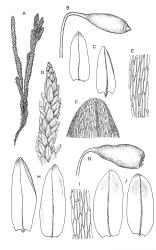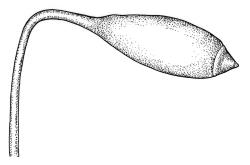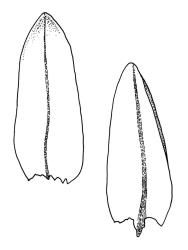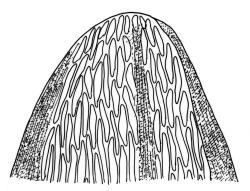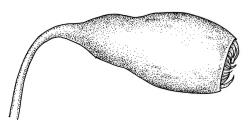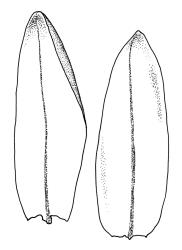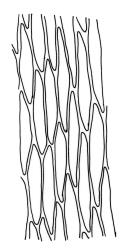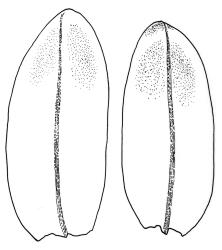- ≡ Bryum blandum Hook.f. & Wilson, London J. Bot. 3: 546 (1844)
- = Bryum blandum var. luridum Hook.f. & Wilson in Wilson, Bot. Antarct. Voy. II (Fl. Nov.-Zel.) Part II, 83 (1854)
- = Calliergon laxirete Zanten & J.K.Bartlett, Cryptog. Bryol. Lichénol. 7: 32 (1986)
Plants dark or pale green, bronze, or cerise, often dirty, sometimes nearly black in portions, usually lustrous, forming loose cushions in flowing water. Stems pink, dark red to nearly black in lower portions, c. 10–80 mm (rarely longer), often forked, sparsely beset below with dark red-brown and nearly smooth rhizoids, in cross-section with firm-walled cortical cells and central strand weak or absent. Leaves evenly spaced on stem, erect and imbricate or erect-spreading when moist, contorted when dry, oblong-ovate, broadly obtuse or rounded and often ± cucullate at apex, 0.7–2.0 mm, strongly concave, usually cerise near insertion or throughout, entire or weakly crenulate above, weakly bordered and plane at margins, not decurrent; upper laminal cells narrowly hexagonal or rhomboid, thin-walled, 5–7:1 and c. (54–)66–90(–105) µm long, becoming shorter and firmer-walled near apex, and longer (to c. 180 µm) towards insertion; marginal cells linear and ± firmer-walled to form a weak border c. 5–6 cells wide and extending above mid leaf; basal cells short, ± oblong in 1–2 rows at base, not markedly pigmented. Costa rather thin, usually ± cerise, subpercurrent. Gemmae absent.
Dioicous. Perichaetia in branch axils, usually near the base shoots, with perichaetial leaves not differentiated. Perigonia terminal or on short, lateral branches, the inner bracts c. 1 mm, broadly oblong-ovate and rounded apically, enclosing numerous antheridia. Setae c. 20–30(–40) mm, red, cygneous just below capsule; capsules uncommon, strongly inclined or pendent, narrowly pyriform, 2.6–4 × 1–1.3 mm, with a well-defined neck nearly ½ the total capsule length and wrinkled when dry; stomata numerous, superficial, restricted to neck; operculum low-conic, not apiculate. Peristome double; exostome teeth pale; endostome with perforate segments equal the teeth, and variably developed but usually rudimentary cilia. Spores variable in diameter, usually (14–)16–22(–36) µm.
Ochi 1968, fig. 1 (as Bryum blandum); van Zanten & Bartlett 1986, fig. 2 a–g (as Calliergon laxirete); Beever et al. 1992, pl. 15 (as Bryum blandum); Malcolm & Malcolm 2003, p. 8 (as Bryum blandum).
The very lustrous plants growing in aquatic situations, together with the ± oblong and obtuse leaves, make Ochiobryum blandum an easily recognised and very attractive species. It varies considerably in stature. Ochiobryum blandum occasionally forms spherical, floating ‘moss balls’ which are attached to the substrate by only a few stems.
Confusion is most frequent between the present species and Bryum laevigatum, a species that also occurs in aquatic situations. B. laevigatum is a coarser plant, with a much stouter costa, which protrudes more strongly abaxially, especially in dry plants. Its upper laminal cells are shorter, wider, and thicker-walled than those of O. blandum, resulting in its coarser appearance. The abundant rhizoids of B. laevigatum are densely and coarsely papillose, in sharp contrast to the sparse, nearly smooth rhizoids of O. blandum.
NI: N Auckland, S Auckland, Gisborne, Hawke's Bay, Taranaki, Wellington; SI: Nelson, Marlborough (Leatham River), Canterbury, Westland, Otago, Southland; Ch; A; Ant; C.
Australasian. Tasmania*, mainland Australia*. The subsp. handelii occurs in eastern Asia.
On rock (granite, greywacke, basalt, limestone, and probably scoria), and coarse sand or gravel in moving water, emergent or submerged (to at least 1.5 m) in swift streams; in seepage over rock or soil; on wet, dripping cliffs. Also sometimes occurring in artificial habitats such as urban storm drains. Usually in strongly insolated habitats, but occasionally in shaded situations in forests. Ranging from sea level to at least 1350 m (Tararua Range, Wellington L.D.) on the North I., and to at least 1600 m (St Arnaud Range, Nelson L.D.) on the South I. Frequently associated aquatic species include Fissidens rigidulus, Tridontium tasmanicum, Cratoneuropsis relaxa, Dicranella cardotii, Bryum laevigatum, and Philonotis tenuis.
The endostomal cilia, usually nodose, can be zero, one, two, rarely three in number, and are rudimentary to well-developed, even within a single capsule. A collection from Maungatua, Otago L.D. (J. Child 6084, CHR 428564) characterises the endostomal variability that is a feature of this species. Between most segment pairs there are one or two tall, nodose, and sometimes anastomosing cilia. Between other segment pairs there are no cilia or a single highly reduced cilium. In a very few specimens (e.g., K.W. Allison 1104, Waitātī, Otago L.D., CHR 542730), however, appendiculate cilia that equal the segments do occur. Such well-developed cilia conform to the description of Sainsbury (1955, p. 275), but do not appear to be common.
The majority of material has spores between 15–22 µm; however, some material from Canterbury and Otago L.D. has been seen with spores either extremely variable in size (c. 18–36 µm in H.D. Wilson BP716, CHR 482776) or with a relatively narrow size range but very large (c. 27–39 µm in K.W. Allison 1103, CHR 542727). Such variably sized or large spores seem to be associated with larger (c. 4 mm long) than average capsules, but the associated gametophytes seem to be quite typical of the species. Taxonomic recognition of these larger-spored populations would serve little useful purpose at present, particularly given the infrequency of sporophytes in this dioicous species.
Bryum handelii Broth., from Yunnan, Formosa, and Japan, was treated as a subspecies of B. blandum by Ochi (1968), who cited a range of N.Z. collections and provided useful illustrations of type material of O. blandum. The cumbersome (but nomenclaturally justified) autonym O. blandum (Hook.f. & Wilson) J.R.Spence & H.P.Ramsay subsp. blandum is not employed here.
The type collection of the var. luridum Hook.f. & Wilson is, as its name implies, a dirty brown form of B. blandum. It falls within the range of continuous variation of the species and is interpreted as merely a shaded environmental form. Some isotypes in Wilson’s herbarium bear the collection number “J.D. Hooker 40".
Jessica Beever (1992) initially realised that the sterile plants comprising the type of Calliergon laxirete belonged to the widespread and common Ochiobryum (Bryum) blandum.




